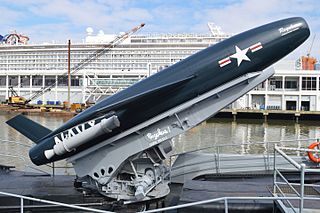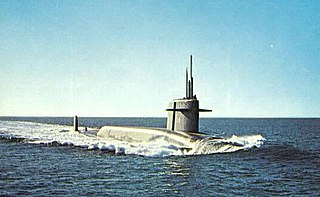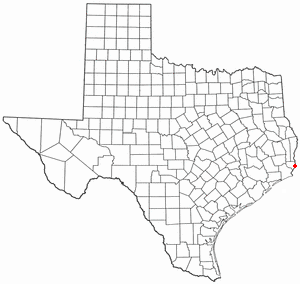
The UGM-27 Polaris missile was a two-stage solid-fueled nuclear-armed submarine-launched ballistic missile (SLBM). As the United States Navy's first SLBM, it served from 1961 to 1980.

The UGM-73 Poseidon missile was the second US Navy nuclear-armed submarine-launched ballistic missile (SLBM) system, powered by a two-stage solid-fuel rocket. It succeeded the UGM-27 Polaris beginning in 1972, bringing major advances in warheads and accuracy. It was followed by Trident I in 1979, and Trident II in 1990.

The SSM-N-8A Regulus or the Regulus I was a United States Navy-developed ship-and-submarine-launched, nuclear-capable turbojet-powered second generation cruise missile, deployed from 1955 to 1964. Its development was an outgrowth of U.S. Navy tests conducted with the German V-1 missile at Naval Air Station Point Mugu in California. Its barrel-shaped fuselage resembled that of numerous fighter aircraft designs of the era, but without a cockpit. Test articles of the Regulus were equipped with landing gear and could take off and land like an airplane. When the missiles were deployed they were launched from a rail launcher, and equipped with a pair of Aerojet JATO bottles on the aft end of the fuselage.

USS George Washington (SSBN-598) was the United States's first operational ballistic missile submarine. It was the lead ship of her class of nuclear ballistic missile submarines, was the third United States Navy ship of the name, in honor of George Washington (1732–1799), the first President of the United States, and the first of that name to be purpose-built as a warship.
USS Franklin may refer to:

The George Washington class was a class of nuclear-powered ballistic missile submarines deployed by the United States Navy. George Washington, along with the later Ethan Allen, Lafayette, James Madison, and Benjamin Franklin classes, comprised the "41 for Freedom" group of submarines that represented the Navy's main contribution to the nuclear deterrent force through the late 1980s.

USS Ethan Allen (SSBN-608), lead ship of her class, was the second ship of the United States Navy to be named for American Revolutionary War hero Ethan Allen.

USS Thomas A. Edison (SSBN-610), an Ethan Allen-class nuclear-powered ballistic missile submarine, was the second ship of the United States Navy to be named for the inventor, Thomas Edison (1847–1931).

USS Will Rogers (SSBN-659) was a Benjamin Franklin-class ballistic missile submarine – the last of the "41 for Freedom" Polaris submarines. She was the only ship of the United States Navy to be named for humorist Will Rogers (1879–1935).

USS Betelgeuse (AK-260) was the last of the cargo ships in service in the United States Navy. On 10 April 1944, it was renamed the SS Colombia Victory after being launched as a Victory ship to carry cargo during World War II. She was transferred to the US Navy in 1951.

USS Sam Rayburn (SSBN-635) was a James Madison-class fleet ballistic missile submarine named for Sam Rayburn (1882–1961), Speaker of the United States House of Representatives. Sam Rayburn was in commission 2 December 1964 to 31 July 1989 carrying the Polaris missile and later the Poseidon missile. Following decommissioning, ex-Sam Rayburn was converted into a moored training ship for use at the Naval Nuclear Prototype Training Unit at Goose Creek, South Carolina.
Polaris is a star, also known as the North Star.
USS Percival may refer to the following ships of the United States Navy:
A number of ships have been named Polaris:

Consolidated Steel Corporation was an American steel and shipbuilding business. Consolidated built ships during World War II in two locations: Wilmington, California and Orange, Texas. It was created in 1929 by the merger of Llewellyn Iron Works, Baker Iron Works and Union Iron Works, all of Los Angeles.
USNS Observation Island (T-AGM-23) was built as the Mariner-class merchant ship Empire State Mariner for the United States Maritime Commission, launched 15 August 1953, and operated by United States Lines upon delivery on 24 February 1954, making voyages for the Military Sea Transportation Service (MSTS) until going into reserve at Mobile, Alabama on 9 November 1954. Title was transferred to the United States Navy on 10 September 1956 and, after conversion, the ship was renamed Observation Island. On commissioning the ship was classified as the "experimental miscellaneous auxiliary" (EAG), USS Observation Island (EAG-154) supporting fleet ballistic missile development. On 1 April 1968 Observation Island was redesignated as a miscellaneous auxiliary USS Observation Island (AG-154). Observation Island was decommissioned and placed in reserve from 1972 until 1977 in the Suisun Bay Reserve Fleet until withdrawn and then returned in 1978. The ship was permanently withdrawn April 1979 and placed in service with MSTS successor, the Military Sealift Command.
USS Plover is a name the United States Navy has used more than once in naming a vessel:

USS Polaris (AF-11) was a Type C2 "Liberty fleet" standard freighter and an Aldebaran-class stores ship acquired from the United States Maritime Commission by the US Navy for World War II and the Korean War. She was built in 1938 at Sun Shipbuilding & Drydock Co., Chester, Pennsylvania.

USS Polaris, originally called the America, was an 1864-screw steamer procured by the Union Navy as USS Periwinkle during the final months of the American Civil War. She served the Union Navy's struggle against the Confederate States as a gunboat.

USS Alcor, AK-259, was a Greenville Victory-class cargo ship in service with the United States Navy from 1952 to 1968. She was originally built in 1944 as SS Rockland Victory, a World War II era Victory ship. She was sold for scrap in 1970.
This page is based on this
Wikipedia article Text is available under the
CC BY-SA 4.0 license; additional terms may apply.
Images, videos and audio are available under their respective licenses.











